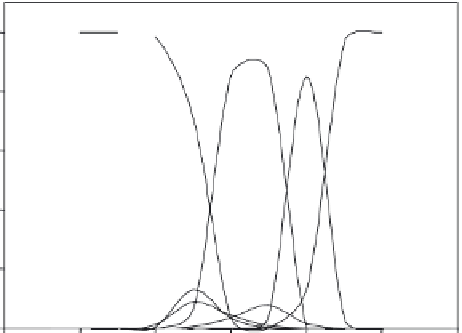Environmental Engineering Reference
In-Depth Information
100%
(UO
2
)
3
(OH)
5+
UO
2+
UO
2
(CO
3
)
4-
2
80%
60%
UO
2
(CO
3
)
2-
40%
(UO
2
)
2
(OH)
2+
UO
2
CO
3
(aq)
20%
UO
2
OH
+
0%
0
2
4
6
pH
8
10
12
FIGURE 9.4
Uranium speciation in aqueous solution with atmospheric CO
2
and total uranium concentra-
tion of 5 × 10
−6
mol/L.
into the uranyl ion and if complexation reactions can occur, the solubility
is enhanced. This can be seen from the pH-Eh diagram of uranium in the
presence of carbonate in Figure 9.5 (calculated using HSC Chemistry [Roine
2007]). The reduction of U(VI) to U(IV) by elemental iron is thermodynami-
cally possible over a wide pH range although stronger reducing conditions
are needed compared to systems in the absence of or with low concentrations
of carbonate. The stability fields of the U(VI)-carbonate complexes are larger
than those of the respective hydroxo-complexes in the absence of or at low
concentrations of carbonate (see dotted line in Figure 9.5).
Elemental iron as a reactive material for the removal of uranium has
already been applied in field experiments (Naftz et al. 2002, CsÖvári et al.
2005a). In Hungary, uranium was mined and processed in the southern part
of the country, in the Mecsek Mountains, near the city of Pécs. The mined out
rock amounted to 46 million tonnes from which different wastes resulted.
Mining activity was terminated at the end of 1997. Rehabilitation of the for-
mer industrial sites is in progress. Among the different remediation tasks,
one of the most important issues is the restoration of the quality of ground-
water contaminated by seepage from tailings, waste rock piles, and heap
leaching residues. A pilot-scale PRB was built at the site near Pécs during the
course of the EU project PEREBAR (CsÖvári et al. 2005b) (Figure 9.9). The PRB
test facility has been in operation since August 2002. The PRB consists of two
different zones: zone 1 with a lower content of coarse elemental iron (12%
by volume or 0.39 t/m
3
, grain size 1-3 mm) and zone 2 with a higher con-
tent of fine elemental iron (41% by volume or 1.28 t/m
3
, grain size 0.2-3 mm).
On both sides (upstream and downstream) sand layers were inserted to




































































































Search WWH ::

Custom Search